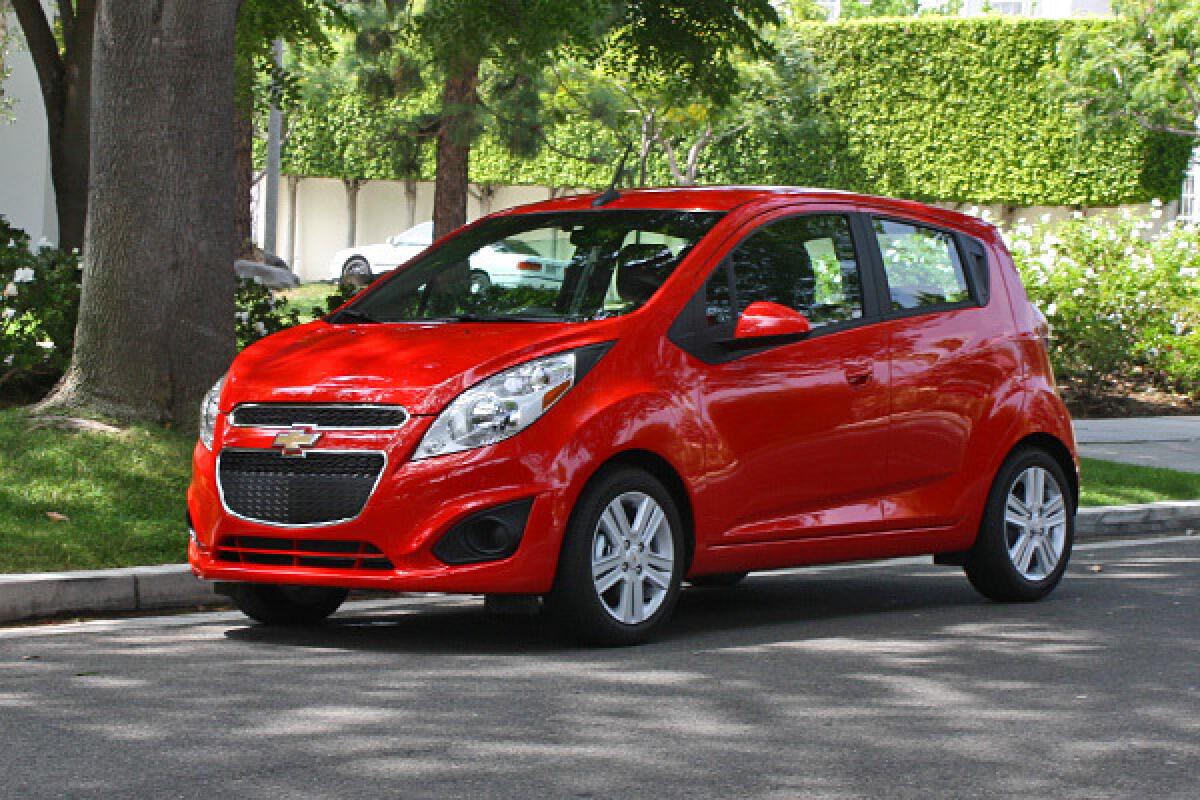First Drive: Chevrolet’s tiny Spark

Chevrolet has found a bit of mojo over the past 24 months in a segment of the automotive landscape that, historically, hasn’t been its strong suit: small cars.
The compact Cruze was a sales leader for much of 2011 and after slowing a bit for some of 2012, was the bestselling car in its class for August. Meanwhile, GM (Chevrolet’s parent) says people bought almost 74,000 of its sub-compact Sonic in its first 12 months on the market.
So Chevrolet is going even smaller with the Spark.
This sub-sub compact car is aimed at the likes of Scion’s iQ, Fiat 500 and Smart Fortwo. It’s a tiny car aimed at the young and the urban for whom budgets and parking spaces are in a competition for which can be smaller.
Chevrolet quietly put the Spark on sale in the States in July but waited several weeks to bring a pile of them to Venice for press drives. Enthused by higher than expected sales since the car has been available, the folks responsible for adapting this Korean-built gumdrop of a car to the U.S. market were eager to show off the latest in Chevrolet’s small-car arsenal.
After a day of driving several models, it’s easy to see why they’re excited.
The Spark starts at $12,995 for the base model (including destination) with a manual transmission. Despite being one of the cheapest new cars available, Chevrolet has managed to include an impressive amount of standard features.
All Sparks come with power windows, air conditioning, OnStar connectivity, 10 airbags, four-wheel anti-lock brakes, a trip computer, alloy wheels, stability control and a five-speed manual transmission. Buyers can part with an additional $925 and get the optional four-speed automatic.
The list of goodies gets even longer when you opt, as Chevrolet expects many buyers will do, for the mid-level model (known at your dealership as the 1LT). This version is $14,495 with the manual tranny and adds Sirius XM radio, steering wheel controls, alarm, cruise control and the piece de resistance, the Chevrolet MyLink infotainment system.
This seven-inch touchscreen syncs with your smartphone to control phone calls and your music library and can also run Pandora and Stitcher SmartRadio via your phone. While a navigation system isn’t available on this system (or on any Spark), buyers will have the option this fall of downloading for $50 an app called BringGo. This app uses your phone’s connection to transmit a full-color navigation system onto the MyLink touchscreen.
This system was on both Sparks I drove and it worked as well as any navigation system on the market today. The maps were richly detailed and plenty intuitive and even featured a GoogleSearch function. Using a smartphone to integrate navigation systems directly into a car will likely become more popular as it saves automakers the trouble and cost of keeping up with the electronic Joneses.
Meanwhile, consumers benefit by avoiding monthly subscription services like GM’s own OnStar and costly navigation options when they buy a new car (often part of a package that can rob you of $1,000 or more).
This healthy amount of swag for a mini car gives the Spark a significant advantage over competitors. Remember that the Scion iQ I tested last year was similarly equipped and had a sticker price of more than $20,000.
Switching away from the goodies, and onto the mechanics, all Sparks are powered by a 1.2-liter, four-cylinder engine that makes 84 horsepower and 83 pound-feet of torque. Yes, such modest figures won’t tear up your local dragstrip, but remember that the Spark weighs around 2,250 pounds. For comparison, the slightly smaller and lighter Scion iQ has 94 horsepower, while the heavier Fiat 500 has 101 horsepower.
The Spark is rated at 32 mpg in the city and 38 on the highway for cars with the manual transmission. Switch to the automatic and those numbers fall to 28 and 37, respectively. For comparison, the Fiat gets 30 mpg city, 38 highway in the manual, and 27/34 with the automatic. Scion’s iQ gets 36 mpg in the city and 37 mpg on the highway.
If you don’t mind rowing your own boat, I’d opt for the manual transmission on the Spark. No car in this segment is quick, somewhat quick or even a distant cousin to quick. But it’s easier to wring more usable power out of the Spark’s manual transmission (and it’s more fuel-efficient). The gearbox feels solid and the shifts are smooth. The four-speed automatic does its job, but it’s clearly geared for efficiency and shifts earlier that you’d hope, thus depriving you of some oomph.
Around town and on the freeway, the Spark feels stable. This may not sound like a groundbreaking assessment, but in a segment full of cars with a wheelbase the length of a end table, stability can’t always be taken for granted. The car is agile enough to scoot through city traffic while freeway jaunts are handled with reassuring ease.
Not only does the car do a nice job of sticking to the ground, but it also feels wonderfully bolted together and solid. Wind and road noise are subdued and the doors close with a solid thunk rather than the clatter of a tin can.
Inside, space is respectable for this segment and certainly comfortable. Having four doors is a significant advantage over the Fiat and Scion and gives the Spark an extra degree of functionality that can’t be overstated when you’re using a car this small on a daily basis.
Meanwhile, there is headroom to spare in both rows of seats, though legroom is a bit tight. Note, however, that a tall person like myself could sit in the back seat for a reasonable amount of time without wondering how they offended the driver. Given the reality that no human could or would fit in between the rear passengers, Chevrolet opted to make the Spark a four-seater and dropped in a plastic cupholder and storage bin between the rear seats.
Behind those seats is a cargo area ready for 11.4 cubic feet of gear, or about two cubic feet more than the Fiat. The rear seats also fold flat, giving users a respectable 31.2 cubic feet of total room.
All this diminutive practicality is wrapped in a shell that may be the Spark’s biggest weakness. This is an odd-looking hunk of metal. Much of this is because the front headlights are enormous, relative to the rest of the car. They rise from the front bumper and extend up the entire side of the Spark, ending almost below the windshield.
The profile of the Spark’s front is also a little wonky as the hood curves sharply up and back and sits high, relative to the beltline (a car’s windowsill, if you will). This creates a funky, disjointed set of lines on the side of the car.
To be fair, designing and packaging a car this small that also looks good isn’t easy. But with the Spark actively targeting the Fiat 500 as one of its key competitors, it’s likely Chevrolet will lose a few sales to people who prefer the more traditional proportions of the 500, as well as the slightly higher cache a European car may have with the urban buyer shopping this segment.
But those who want a superior value, hearty construction, plentiful space (for a mini-car), and can live with a quirky exterior have a lot to like in the new Spark. It’s nice to see Chevrolet think small.







